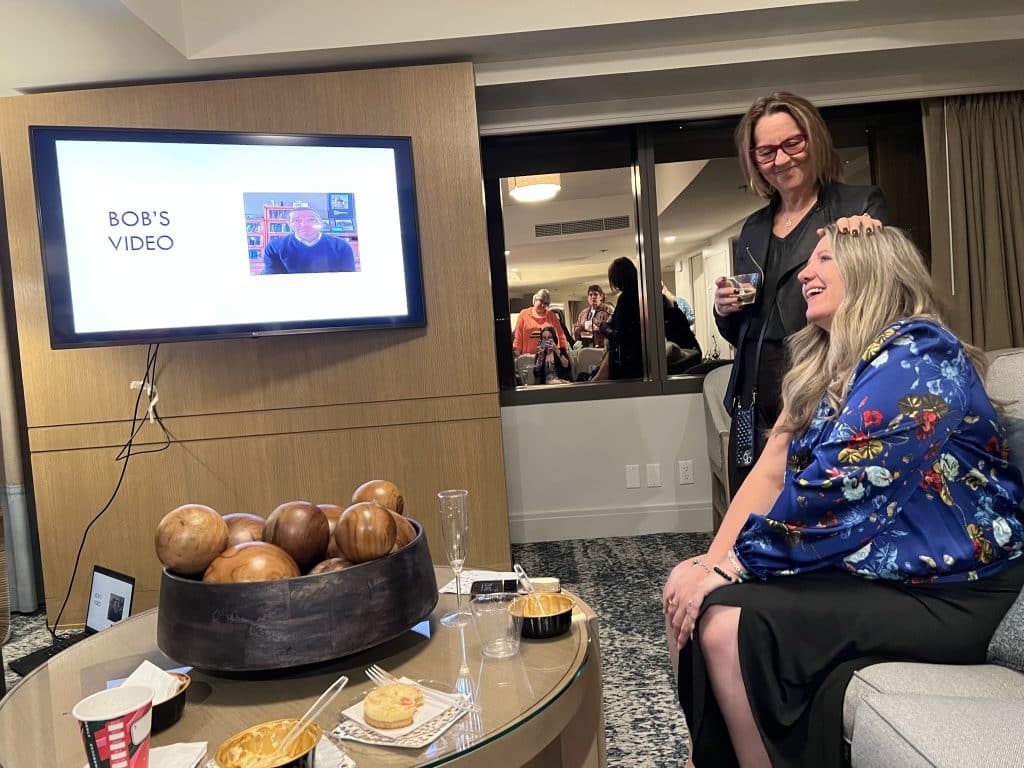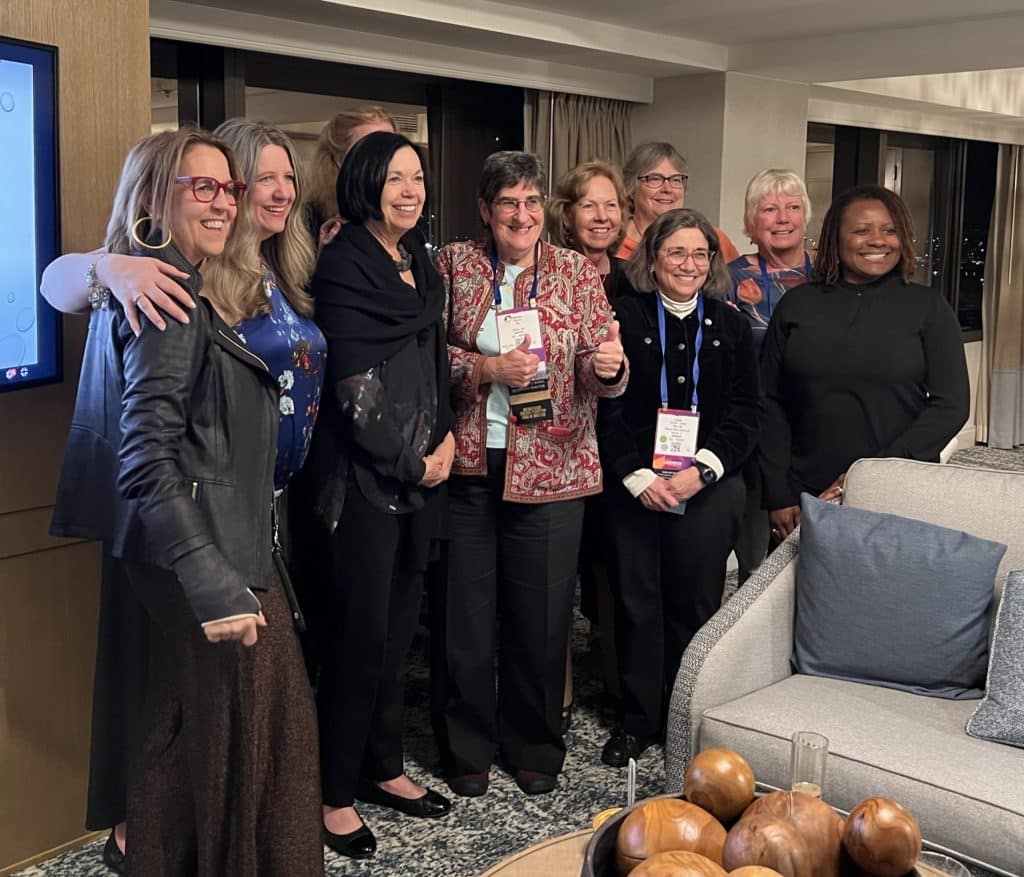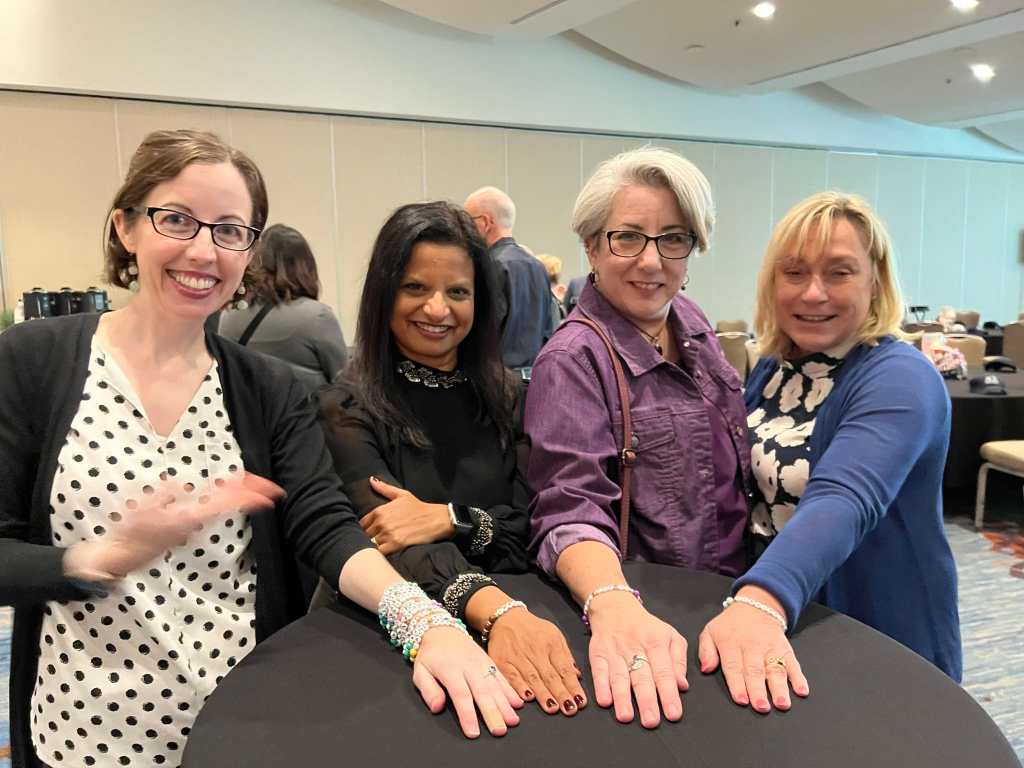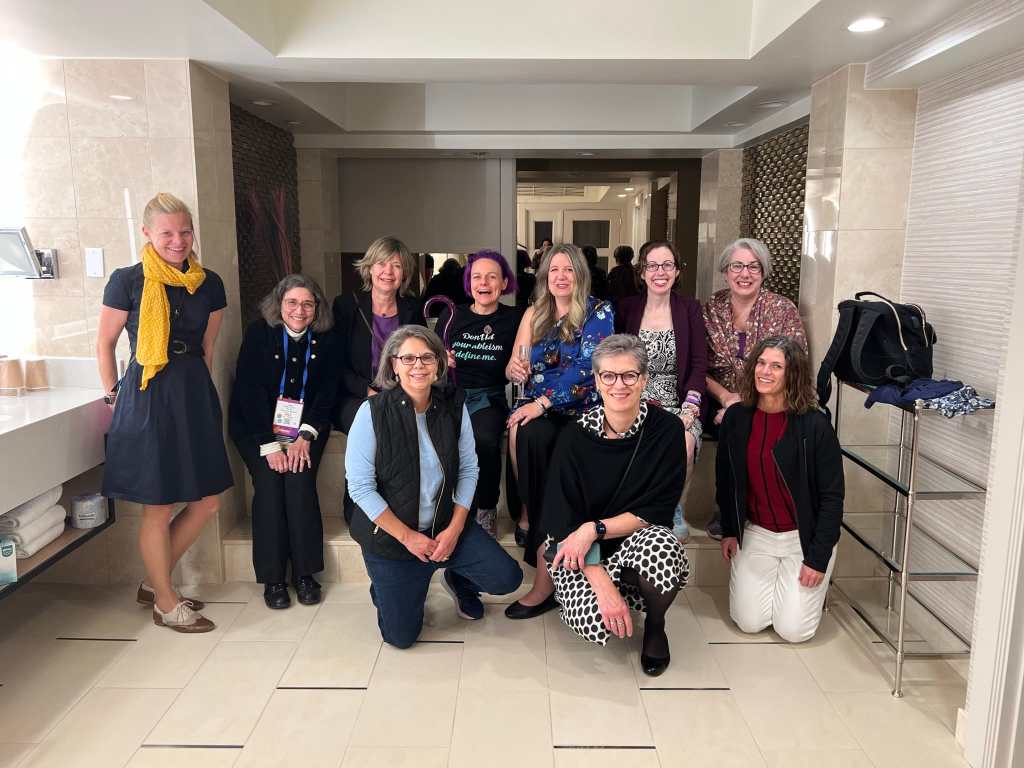Last week, I had the pleasure of attending the American College of Rheumatology’s “Convergence” conference, where I learned some of the latest rheumatology research and advancements in the field. This is a multidisciplinary conference, bringing together the American College of Rheumatology (the professional association for doctors) and the associated Association of Rheumatology Professionals (the association for allied health providers like me, an occupational therapist).
I also had the pleasure of connecting with many old friends, including fellow patient advocates, fellow allied health providers (occupational therapists, physical therapists, nurses and more), rheumatologists, patient centered nonprofits, and researchers. I’m excited to share some of my main takeaways with you, and please feel free to click through this 17 photo slideshow to catch a glimpse of the event.
My Goals in Attending Convergence
As an occupational therapist living with rheumatoid arthritis, and as the creator of the Rheum to THRIVE comprehensive self-management and support group program, my main goals in attending the conference were to discover new ways to improve quality of life for people with inflammatory arthritis (IA) based on the latest rheumatology research. Specifically, I wanted to:
- Learn the latest evidence-based methods for reducing fatigue and pain, with a focus on non-pharmacologic or lifestyle methods (exercise, nutrition, stress management, sleep and rest, etc).
- Learn better ways to improve mental health for people living with IA.
- Connect, share ideas and build community with other passionate rheumatology enthusiasts / organizations, celebrate advancements in the field and nerd out in person about ways to improve patient care!
- Speak on two different panels at the event (one about meeting the psychosocial needs of people with inflammatory arthritis in the workplace, and one about ways to make an effective rheumatology themed podcast!).

I always leave these kinds of events feeling equal parts inspired, exhausted, thrilled and overwhelmed. Now that it’s been over for almost a week, I’m happy to share some of my biggest takeaways with you today.
Takeaway # 1: Exercise, Physical Activity & “Psychoeducation” can Reduce Fatigue For Rheumatoid Arthritis & Similar Conditions
Just add this to the list of paradoxes in the field of autoimmune arthritis: sometimes when your body tells you to rest, you might actually be better off expending energy (via exercise / physical activity) in the short term!
Yup, you guessed it: exercise continues to be an evidence based nonpharmacological intervention for fatigue. After facilitating many patient education and support groups, I understand how deeply intuitive this is, but it’s a super important tool in the toolbox when it comes to lifestyle interventions to improve quality of life!
I was beyond thrilled to discover that for the very first time, there’s an evidence based guideline for the non-medicinal management of inflammatory arthritis fatigue, which is based on the latest rheumatology research. The “2023 EULAR recommendations for the management of fatigue in people with inflammatory rheumatic and musculoskeletal diseases” pointed to the importance of exercise, psychoeducation and continued monitoring of fatigue in inflammatory arthritis.

The 2023 EULAR guidelines recommend:
- Regular screening of fatigue (as in: your doctor asking about it at every rheumatology appointment) (Cheryl’s side note / soap box: why is this not already being done? I have no idea other than that providers tend to focus on joint pain / swelling because it’s more observable to their eye / “more objective,” regardless of whether the presence of joint pain or swelling functionally impacts the patient, and fatigue is seen as less objective / measurable, even though it can profoundly negatively impact function / quality of life)
- Offering tailored exercise and encourage increased physical activity
- Offer tailored psychosocial and psychoeducational interventions
- In the presence of fatigue, the provider should evaluate inflammatory disease activity

You can read the full literature review informing these recommendations, which echo the 2022 American College of Rheumatology guidelines for the integrative management of rheumatoid arthritis. In those guidelines, “consistent engagement in exercise was the most strongly recommended lifestyle factor/intervention, above any dietary / nutrition factor or even occupational therapy!
This certainly influenced my decision to hit the gym when I came back home from San Diego after the conference, but it’s important to recognize that increasing physical activity does not necessarily mean traditional exercise. Dance, yoga, and walking the dog are all great examples of ways to get your joints moving!
I was also interested to see A Longitudinal Study: The Benefits of Non-Pharmacological Approaches to Improve Self-Reported Pain, Stiffness, and Fatigue in Individuals with Musculoskeletal Disorders,” where the researchers found that: “for every 6-week virtual physical activity program, participants reporting at least one musculoskeletal condition experienced statistically significant decreases in pain intensity (p≤0.01), stiffness (p≤0.01), and fatigue (p≤0.05).” I was particularly interested in this as it was delivered virtually and thus more accessible to patients than in person programs!
I was also quite interested to see this study: “Self-reported Levels of Physical Activity and the Association to Pain, Fatigue, Anxiety and Depression Among Patients with Idiopathic Inflammatory Myopathies.” The researchers surveyed patients and found a correlation between physical activity and depression, where people with higher physical activity levels showed less depression. The relationship between physical activity and fatigue was unclear, but in this study the people with worse fatigue showed a greater likelihood of having depression or anxiety, not surprisingly.
One last but important note on fatigue interventions in the rheumatology world: in “A Peer Health Coached Resilience-Based Energy Management Program Was Effective in Improving Fatigue and Other Outcomes in People with Systemic Sclerosis: Results of a Randomized Controlled Trial,” researchers concluded that a program facilitated entirely online by peers had a very positive effect in reducing fatigue in people with systemic sclerosis. This is fabulous news as remotely delivered psychoeducational programs are so much more scalable than in person ones, plus of course I was thrilled to see that it was effective!
Takeaway #2: The Patient Remains the CEO of Their Care (+ Patient Stories MATTER)
Dr Kaleb Michaud gave an incredibly powerful talk titled: “ARP Distinguished Lecture: From Then to Now to When – Perspectives from 45 Years of Patient Experience with Hope for Tomorrow.” He interweaved his personal experience growing up with juvenile idiopathic arthritis, which eventually led to 22 years of rheumatology research.
At one point, Dr. Michaud said that as a child, his doctors’ goal was to get him to merely survive to adulthood. It certainly underscores the systemic nature of JIA and the fact that it has so much more effects than simply “joint pain” (arthritis).

As Dr. Michaud’s childhood was only 30-40 years ago, to me this completely underscored how transformational modern medications are at the population level. When I volunteer at the Arthritis Foundation summer camps for kids with juvenile idiopathic arthritis now in 2023, I see kids whose goals are not just to maybe survive to adulthood, but whose goals are to live a live unencumbered by severe disability, pain and fatigue. As a patient educator, I’m often confronted with patients who are extremely medication hesitant, which I understand particularly during the pandemic. But I believe the historical perspective is crucial for patients to understand – the risks of the medications must be weighed against the risks of uncontrolled disease.
Additionally, I was deeply affected by how Dr Michaud explained this realization: “I didn’t realize this until much later in my life, that my doctor is not the one taking care of me “I’m the one taking care of me. They provided the tools for that to happen.” Through my lens as both a patient and occupational therapist / patient educator, this truly highlights the importance of patient empowerment and the development of self-management skills. Self-management, or the tools to manage the day to day of your condition, can absolutely be taught systematically, which I do in my Rheum to THRIVE program. Unfortunately so many patients are left on their own to figure out how to actually manage the day to day, I truly hope that there are more self-management groups and programs available to people in the future.

One last thought from this talk was simply how incredibly powerful the patient voice is. The conference is, understandably, chock full of in depth scientific presentations on the latest medications and developments at the cellular level, but as a “top-down” occupational therapist, I find myself most excited by developments that center the patient’s lived experience. I hope that in the future the patient voice is woven into the conference in more systematic ways, beyond the inclusion of voices like Dr. Michaud’s and mine who represent both a ACR / ARP member and patient perspective in one. The patient perspective posters in the poster hall are a great start!
Takeaway #3: Inflammatory Arthritis in the Workplace: Patients need Psychosocial Support (not just ergonomics)
In her poster “The Psychological Experience of Work for People with Inflammatory Arthritis (IA),” Joan Westreich (LWSW) presented the results of a qualitative study which showed “significant psychological impact related to IA patients’ efforts to maintain employment while coping with the challenges of their illness. This nuanced perspective is an important area of inquiry for a more holistic patient assessment and can inform multidisciplinary interventions to support IA patients at work” (citation: Joan’s abstract).
After completing in depth interviews of patients living with inflammatory arthritis, Joan and her team uncovered nine main themes of the challenges people with IA experience at work:

- Challenges to identity and pride (achievements, coping with illness’ impact on work)
- Guilt or shame (diminished capacity, internalized ableism)
- Managing perceptions (attempts to process and cope with perceptions of others)
- Grappling with disclosure (and potential consequences)
- Pushing through (internal/external pressure to function, presenteeism)
- Financial security (living costs, healthcare)
- Mental health impact (stress, anxiety, anger, depression reflected in all study themes)
- Personal/professional support (complex, variable, vital to sustaining work, often inadequate)
- New perspectives, transformations and meaning-making (evolving priorities and values).
These themes are really consistent with what I’ve seen in the support groups I’ve facilitated as well. People living with inflammatory arthritis need support to navigate the complex psychosocial experience of navigating illness disclosure, internalized ableism, societal ableism and more!
I was honored to sit on a multidisciplinary panel to discuss these issues in depth, along with social worker Joan Westrich, social worker Adena Batterman, occupational therapist Dr. Janet Poole, Take a Pain Check founder Natasha Trehan (check out her interview on the podcast), and rheumatologist Dr Diane Lacaille.

I discussed how occupational therapy professionals can support the comprehensive needs of people with inflammatory arthritis at work, and focused on ways that many people end up falling in the “messy middle” where they are “too sick to work full time, too well to quality for disability.”
I also discussed the difficulty of securing accommodations for a fluctuating illness, as many others in the work environment often wonder “if you could do X yesterday, why can’t you do it today?”
Dr Lacaille shared helpful tips from her “Making it Work (TM)” program and all speakers discussed the complexity of the decision around whether or not to disclose one’s disability in the workplace. Overall we made the case that psychosocial stressors should be addressed by the multidisciplinary team and patients shouldn’t be left all alone to figure out how to thrive in the workplace.
Interestingly, in “Factors Associated with Work Productivity Among Individuals with Psoriatic Arthritis (PsA) and Psoriasis (PsO): The Role of Patient Reported Outcomes and Disease Severity,” researchers found that fatigue rather than joint pain accounted for “impaired work productivity” for people with PsA versus those with PsO alone – this is not surprising but important to document, as many people assume that the joint pain is the main factor that should be addressed or accommodated for in the workplace.
Takeaway # 4: Pharmacologic Therapies for Inflammatory Arthritis Also can Reduce Fatigue
Back to fatigue, one of my biggest priorities in attending the conference: I was encouraged to see this systematic review which points to the efficacy of many medications for rheumatoid arthritis and spondyloarthritis in reducing fatigue alongside joint pain and overall disease activity. The abstract includes a handy chart which showed that some medications were more effective for fatigue than others.
I’m hopeful that this can help patients and providers during the shared decision making process in the future, as I hear a lot of stories from patients who say their doctor appears unwilling or incapable of addressing the patient’s lingering fatigue.
Takeaway #5: Stages of Grief are *not* Sequential, and they are Experienced Throughout one’s Life (not just at initial diagnosis)
In session “14T123: A Thousand Tiny Deaths: Attending to Grief in Patients with Rheumatic Diseases,” Dr Courtney Wells (social worker and researcher) explained that the popular “stages of grief” from Dr Elisabeth Kübler-Ross were *never* meant to be linear. I really appreciated her “scribbled over” graphic explaining how the stages of grief are messy and overlapping and not sequential. This certainly has been my experience living with rheumatic disease, and the experience of many in my Rheum to THRIVE support groups.

I also really resonated with occupational therapist Rebecca Gilette’s perspective. She said, “I had to grieve that I couldn’t be the mom I thought I would be (due to rheumatoid arthritis),” yet though her grief she developed resilience and adapted to all the ups and downs of life with RA.
She also emphasized that grief is NOT just experienced upon initial diagnosis; it comes with each new “no,” new “I can’t do,” new health crisis, new loss of function , identity and role – it’s a “thousand tiny deaths” of the person you thought you would be before your diagnosis, and patients need support navigating it.
The speakers had some ideas for how providers can help patients navigate grief, including:
- Validate the patient’s feelings
- Connect patient to members of interdisciplinary team who can help develop emotional coping skills (social work, counseling, OT)
- Ask: how can I help?
- Remind them“it’s ok not to be ok,” there’s no rush to get to an end point of being “over it”
I enjoyed the chance to connect with Rebecca about this topic more at one of out multidisciplinary lunch meetings!

Takeaway #6: Cardiology and Rheumatology: a Match Made in Heaven
There’s a new interdisciplinary team on the block and it’s called “cardio-rheumatology.” In this session, the speakers provided an overview of an emerging field where cardiologists and rheumatologists work closer together to mitigate cardiovascular risk in RA. They discussed newly FDA-approved anti-inflammatory agent colchicine which reduced cardiovascular events by 30%.
It’s well documented that people with inflammatory arthritis are more likely to experience cardiovascular problems than the average person, but scientists are still figuring out what precisely to do to mitigate the risk since it often persists even when the patient’s inflammatory arthritis is well controlled. This is something I will keep a close eye on as I age, and it’s a major motivator for me to continue exercising as this is at least under my control!
Takeaway #7: Connecting in Person and Building Community is Important for Longevity and Burnout Prevention
Honestly, the biggest highlight for me of the entire experience was making new friends and reconnecting with old ones. There’s nothing like being surrounded by people whom are as passionate about patient care and patient education as you are. Every nonprofit booth I visited in the Expo Hall inspired me in some way, and left me feeling invigorated and a continued sense of dedication to the work I do with Rheum to THRIVE, the Arthritis Life Podcast and Arthritis Life as a whole.

Sometimes I see so many problems in the healthcare field as a whole, from insurance denials to pharmacy benefit managers, it’s easy to get anxious and frustrated and feel a “moral injury.” While developing my support groups, I have been careful to craft them to include a balance of venting about what’s wrong, along with focusing on what’s right or what’s still possible in terms of crafting a vibrant, meaningful existence within the confines of chronic illness.
At the conference, I was surrounded by so many warm, competent, caring professionals, nonprofit organizations and patients that it truly made me optimistic for the field as a whole. I saw so many people working tremendously hard to improve the quality of life for patients, from rheumatology researchers to nonprofit services. Experiences like this conference almost seem like an antidote to burnout among clinicians (at least super extroverted ones like me!). The inclusion of rheumatology themed bracelet trading was simply icing on the cake, bringing a splash of color, joy and fun to the occasion!


On a more micro level, there were so many small simple moments that brought joy to my heart. One of them was meeting Dr Jason Leibowitz, MD (Columbia University Medical Center) and his father prior to the podcast panel I spoke on, called “Going Viral: How to Achieve Podcast Success” (session #13M112). On the top right picture above, you can see Dr. Liebowitz’s father proudly taking pictures of him as he introduces our panel (I promise there were actually more people in the audience, it was just a big room!). It was so sweet to see the look of joy and pride on Dr. Liebowitz’ father! It’s hard to explain it in words, but I truly felt a sense of awe and celebration amongst the attendees at many of the talks, and it was fulfilling to be in the milieu of this grand event.
I was also inspired to meet and learn from Dr Puja Mehta, who delivered a resounding lecture called “Redefining Imposter Syndrome: Eliminating Bias and Transforming Culture.” She made a strong case that imposter syndrome (when someone feels less competent than they are) should not be solved at the individual level, whereby the person feeling imposter syndrome goes off to learn how to “develop resilience.” Rather, it should be addressed at the social / societal level, whereby we eliminate the biases that led to the person with imposter syndrome’s perception that they lack credibility in the first place.
She explained that the biases often come from “testimonial injustice,” whereby the prejudice of the listener determines the credibility of a speaker. For example, if the speaker is from a systematically marginalized group (such as women, ethnic minorities, disabled, etc), the listener will determine that they are less credible by virtue of their inclusion in that group, which is obviously unjust. She also made some fascinating points about the ways to actually combat this – it turns out that “implicit bias training” actually has backfired in many cases and not led to behavior change. We might be better served by following the 4 As of inclusion: Acknowledge the problem, raise Awareness, have Accountability, and take Action.
It was one of the talks I heard people reference again and again throughout the conference and I know it will be sitting with me for a long time. I also had the great pleasure to meet Dr. Mehta and exchange bracelets with her before she hopped back on her flight to London, and her energy was just live-giving!


Another inspirational moment was spending time with ARNP Kori Dewing, the president of the Association of Rheumatology Professionals. I know just a little about how hard she’s worked behind the scenes to improve rheumatology care (and she even appeared on the podcast to discuss ways to approach difficult medical decisions!).
It brought me so much joy to see her be celebrated during the conference. There was even a gorgeous slideshow featuring all of her volunteer work over a few decades, concluding with her family giving their supportive testimonials. Seeing Kori gather with all the past ARP presidents, some of whom are retired, also greatly inspired me. These people are so passionate about the field that they continue coming back to this conference year after year, and still want to learn and contribute to the field!



Takeaway #8: Scientific Findings that Piqued my Interest
Ok, since I can’t keep this to just eight things (those of you who know me will not be surprised), I had to group together some of the scientific developments that I found helpful into one last set of takeaways. I put these together since they are more geared towards doctor level providers, people with medication prescribing power and/or researchers, versus my area of expertise (occupational therapy – we don’t prescribe meds or diagnose conditions).
**Rheumatology Year in Review
In the “Year in Review” rheumatology research session, Dr. Philip Seo referenced recent research from the Global Burden of Disease study which showed that osteoarthritis (OA) has increased greatly in prevalence from 1990 (256 million people) to 2020 (595 million, 7.6% of the global population). This was true for hip, knee, and hand osteoarthritis. This is an important takeaway for me as an occupational therapist as well as an RA patient, because I know that having RA predisposes me to OA.
The “Year in Review” aso includes some interesting developments in psoriatic arthritis, ankylosing spondylitis, and lupus as well as RA. Of note, there are some new medications on the horizon for those conditions and new research furthering scientists’ understanding of the causes of these conditions. You can also peruse this set of 2 handy graphic summaries from Dr. Mithu Maheswaranathan on Twitter / X as well.
**RA may be conceptualized as a “mitochondrial disease”
Now, this rheumatology research session didn’t necessarily have a lot of practical applicability for me at present, but nevertheless I found it fascinating as it could lead to some interesting future research and treatments. In “Rheumatoid Arthritis as a Mitochondrial Disease,” Cornelia M. Weyand, MD, PhD gives a fascinating take on RA.
As the press release for her talk (linked above) says: “According to Dr. Weyand, T cells in patients with RA contain defects in the electron transport chain and the Krebs cycle, leading to energy depletion and miscommunication with other organelles” which eventually leads to hyperproduction of tumor necrosis factor (TNF) alpha, a cytokine that is involved in RA disease activity and often is the target of pharmacological treatment.
The press release continues: “For the previous 50 years of RA therapy, providers have traditionally suppressed patients’ immune systems with inhibitors to eliminate cell proliferation, which reduces inflammation. Dr. Weyand believes this strategy has ultimately prevented researchers and physicians from properly considering therapeutic methods that strengthen the immune system rather than weakening it.”
This is obviously timely for many of us living with inflammatory arthritis who respond well to medications but don’t enjoy the side effect of increased risk of infection!
** Does fatigue correlate to findings within the joint itself?
Continuing my quest to discover WHAT is actually going on when it comes to inflammatory arthritis fatigue, another finding that piqued my interest was “Patient-Reported Fatigue Associated with Joint Histopathology in Rheumatoid Arthritis.” Since the etiology (cause) of fatigue is still poorly understood in rheumatoid arthritis, the researchers wanted to understand “whether patient-reported fatigue is associated with histologic changes in the synovium in both low and high disease activity patients.”
Their conclusion was: “In patients with low disease activity, fatigue is associated with chronic lymphocytic joint inflammation but not with anxiety or depression, suggesting an association with subclinical synovitis. In contrast, in RA patients with high disease activity, fatigue is associated with anxiety and synovial lining hyperplasia but not chronic lymphocytic inflammation.”
** Discontinuing TNF inhibitors might lead to RA flares
This is one of those developments I wasn’t thrilled to see, but I’d rather be aware of it than not! This Study shows that discontinuing TNF inhibitor medication led to flare ups in people with rheumatoid arthritis who previously were in medicated remission. This is important because some people wish to taper down on their meds once they’ve sustained a medicated remission. As always, speak with your doctor about medication decisions and see my medical disclaimer!
Conclusions
Despite the length of this blog post, this is only a teeny tiny fraction of what was actually covered at the conference. There were hundreds of abstracts accepted, I’m guessing over 1,000 presenters and over 13,000 people attended the event! I hope that this gives you just a small sense of how enriching a conference like this can be, and if you have any questions I’d be happy to answer them in the comments!
























Thanks so much for sharing. I look forward to coming back to this and reading in detail.
Was there any discussion of VNS as a treatment?
This is a brilliant round-up Cheryl – thank you! I felt the same about connecting with others and the importance of the patient voice after attending EULAR congress earlier in the year. Dr Weyands theory is something I’ve often wondered (though I’m totally non-scientific!) but I’ve always been fascinated by the story of Lorenzo’s oil and it was by boosting rather than inhibiting that found the cure for that. Love your bracelets! My daughter is still busy making Swiftie ones but it’s a great idea to make them for chronic conditions too – She might do that with some of her JIA friends.
Thank you so so much for taking the time to respond! It was great to connect during our recording and I can’t wait for our episode to come out in March!